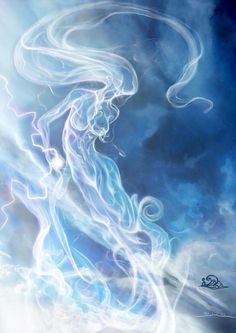
The Sylph (also known as Sylphid and Sylphide) is a spiritual creature associated with the element of air and in some beliefs, wood. Along with the
Undine (Water),
Salamanders(Fire), and
Gnomes(Earth), Sylphs are considered to be the Elementals and personifications of the air, and are called upon in some spiritualistic and religious practices. In Wicca and other Pagan practices, they are usually invoked in rites, rituals, or spells concerning the element of air or the wind, and are represented by either an Athame, Knife, or Incense. They are also thought to be Faeries (See:
Fairies) who are particularly attuned with the wind, trees, and other forms of nature. They were also said to have originally been associated with the science of Alchemy, in European lore. Along with this, they were said to also have a ruler known as, Paralda
Sylphs are thought to be seen or manifest as certain cloud shapes in the sky. Whether thoughtful illusion of the eye or the real deal, is, in fact, hard to decipher.
Their name is derived from the Latin word Silva (Meaning: Wood,) and the Greek Nymphe (see:
Nymph)
Atrributes: Magick, Nature, Wisdom, Female Energy.
Type of Creature: Elemental (possibly faery as well).
Behavior: Varied.
Element: Air.
Symbols: Athame, bell, incense, Knife (If the person feels that the Athame is more masculine than feminine).
Appearances in media:
- The 1712 poem, Rape of the Lock, by Alexander Pope, described Sylphs as vain women who died and whose spirits were filled with so much dark vapor that they couldn't ascend into the heavens. They were mainly used in this poem as an allegory to explain the failings of Alchemy.
- They are also mentioned in Magic Kingdom of Landover, by Terry Brooks, where a woman is described as a Sylph and the wife of the protagonist,
- Sylphs make multiple appearances in various games of the Final Fantasy and Tales series as Summons and Summon Spirits, respectively.
- They were mentioned in the Ballet, La Sylphide, where they are identified with faeries and, however, unlike other various, they were thought to haunt graveyards.





 Added link to Salamander.
- TheElegantShadow
Added link to Salamander.
- TheElegantShadow